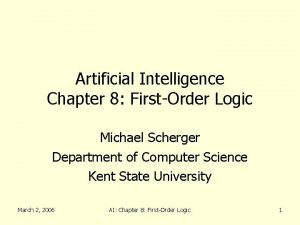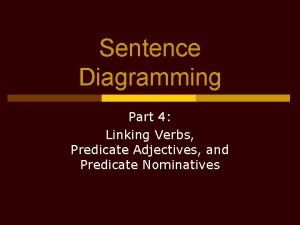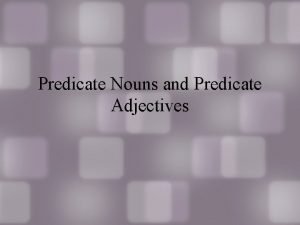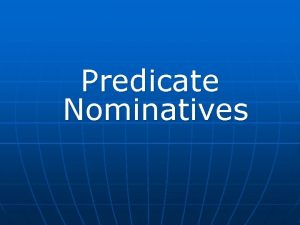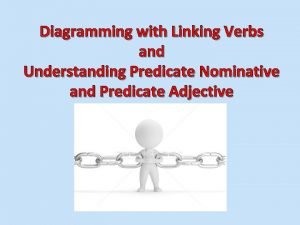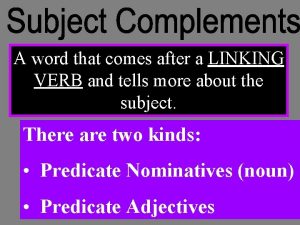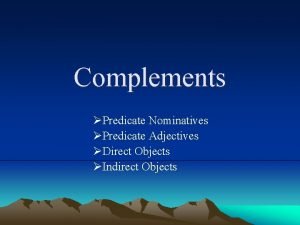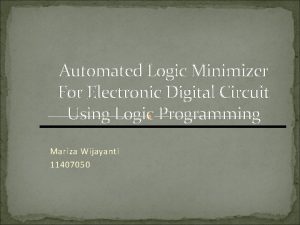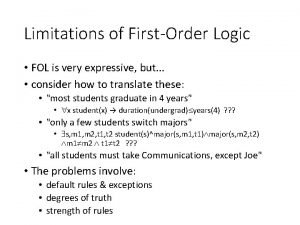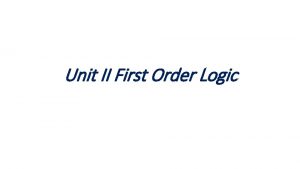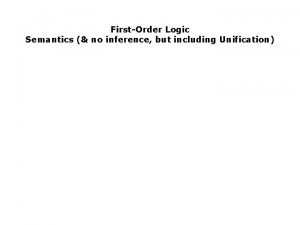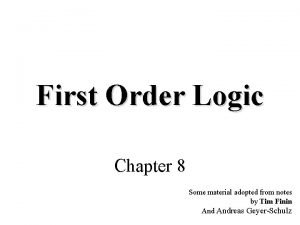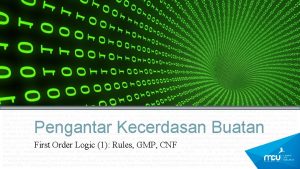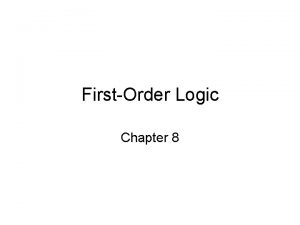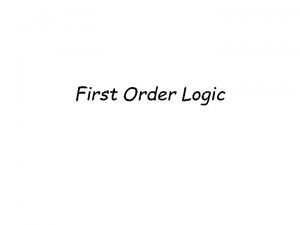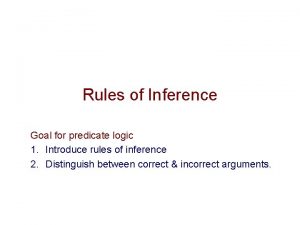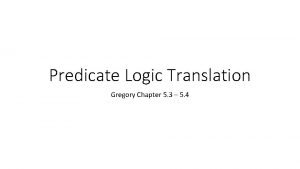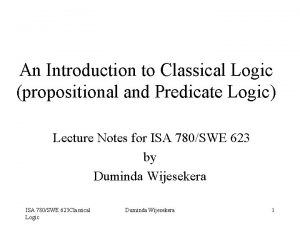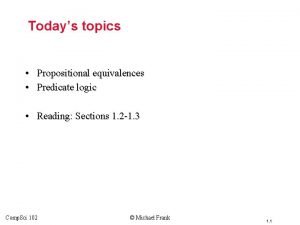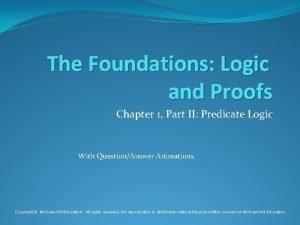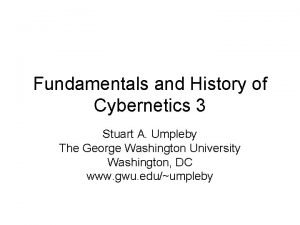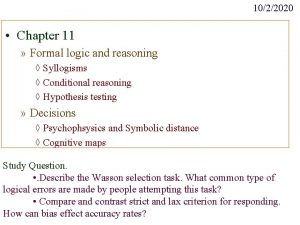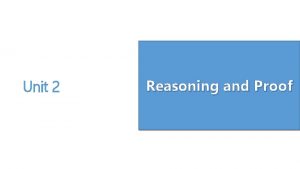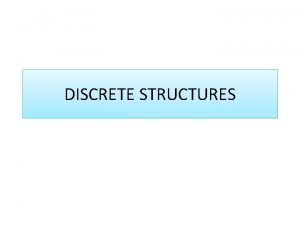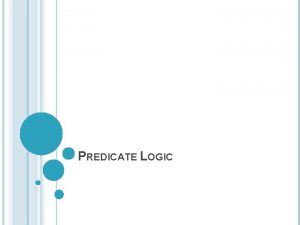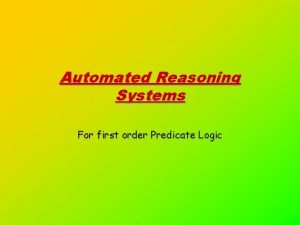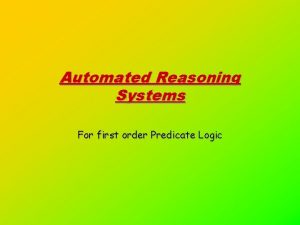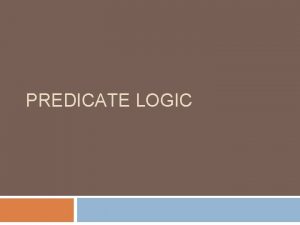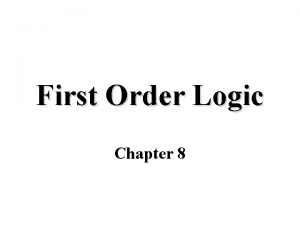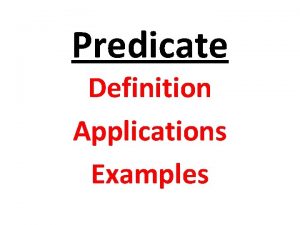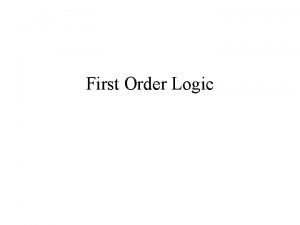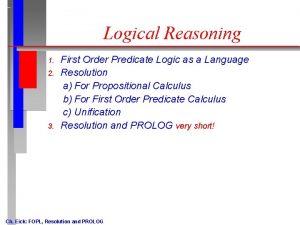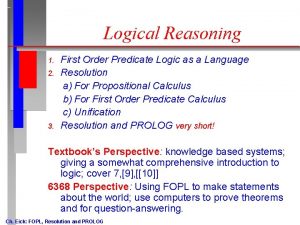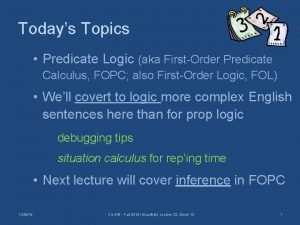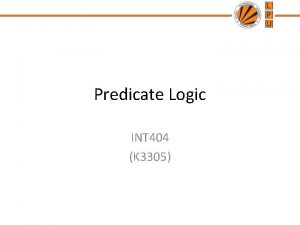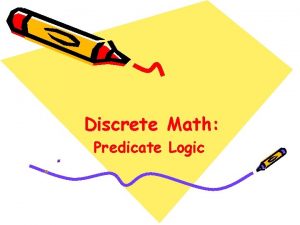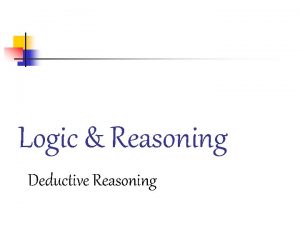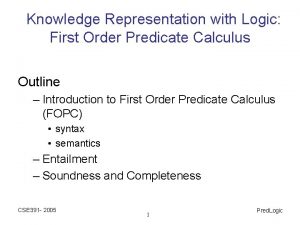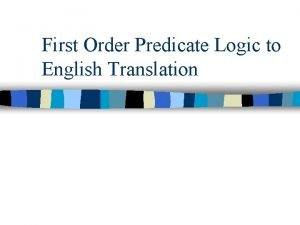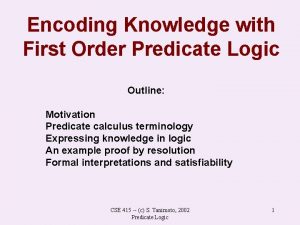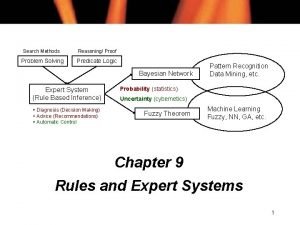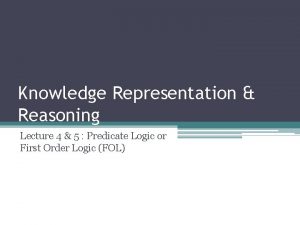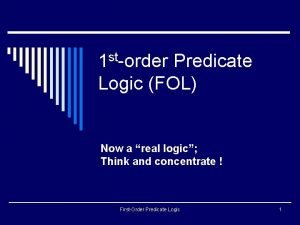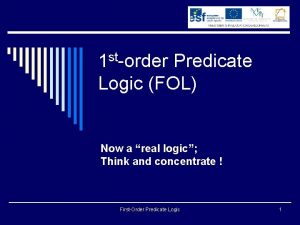Automated Reasoning Systems For first order Predicate Logic

















































- Slides: 49

Automated Reasoning Systems For first order Predicate Logic

AR: general context. ¤ Given is a knowledge base in predicate logic: T è is a set of formulae in first order logic è formally also called: a “Theory’’ ¤ Given is also an additional first order formula: F ¤ Is F a logical consequence of T ? è Notation: T |= F (T implies F) ¤ Find reasoning techniques that allow to decide on this for EACH F and T. ¤ Requirements: è correctness -- completeness -- efficiency 2

AR: decidability. ¤ Theorem Church ‘ 36: è There CANNOT EXIST AN ALGORITHM that decides whether T |= F, for any theory T and any formula F. ¤ BUT: semi-decidable ! ¤ Completeness Theorem of Goedel ‘ 31: èThere exists a reasoning technique, such that for any theory T and formula F, such that T |= F, the reasoning technique proves T |= F. ¤ SO: if F follows from T, then we find a proof, else it is possible that the procedure doesn’t terminate. 3

Wait a second. . . ¤ The theorems of Church and Goedel are contradicting: We can try to prove F and ~F in parallel, and according to Goedel’s theorem one of these must succeed after a finite time. ¤ Wrong ! ¤ Let: T = {smart(Kelly)} en F = strong(Kelly) ¤ Although strong(Kelly) ~strong(Kelly) is always true, we have: è neither: {smart(Kelly)} |= strong(Kelly) è nor: {smart(Kelly)} |= ~strong(Kelly) 4

AR: general outline (1). ¤ First we sketch the most generally used approach for automated reasoning in first-order logic: è backward resolution ¤ The different technical components will only be explained in full detail in a second pass (outline (2)). 5

AR: general outline (2). ¤ We study different subsets of predicate logic: è ground Horn clause logic è Clausal logic è full predicate logic ¤ In each case we study semi-deciding procedures. ¤ Each extension requires the introduction of new techniques. 6

Backward Reasoning Resolution … in a nutshell

Backward resolution: 0) The task: an example. 1) Proof by inconsistency. 2) Conversion to clausal form. 3) Unification. 4) The resolution step. 5) (Backward) resolution proofs. 8

0) The TASK (example): T z y x ~ q(z) p(f(y)) p(x) q(x) r(x) p = parent f = father r = rich q = old ¤ Are axioms: describe knowledge about some world. ¤ In this world, is F u r(f(u)) always true ? ¤ How to prove such theorems in general? 9

1) Proof by inconsistency ¤ Don’t prove F directly: F u r(f(u)) ¤ But add the negation of F to the axioms and prove that this extension is inconsistent. ¤ NEW TASK: is inconsistent. ~ u r(f(u)) z ~ q(z) y p(f(y)) x p(x) q(x) r(x) ® the 4 axioms are never true in 1 same interpretation. 10

2) Clausal form: = Normalize the formulae to a (more simple) standard form. ¤ Each set of axioms can be transformed into a new set of formulae, that contains only formulae of the form: x y… z p(…) q(…) … r(…) t(…) s(…) … u(…) è only left; only right è no ~ ; no which is inconsistent if and only if the original set was inconsistent. Notice: “ x y … z“ can be dropped. 11

Example: ¤ ~ u r(f(u)) u false r(f(u)) ¤ z ~ q(z) z false q(z) ¤ y p(f(y)) : is already in clausal form: ( P P true) ¤ x p(x) q(x) r(x) x q(x) r(x) p(x) Ps: usually requires much more work! 12

3) Unification: ¤ Given 2 atomic formulae: è Ex. : p(f(A), y) p(x, g(x)) find their most general common instance. è Ex. : x must become: f(A) g(x) must become: g(f(A)) y must become: g(f(A)) p(f(A), g(f(A))) ¤ Most general unifier (mgu) : x -> f(A) y -> g(f(A)) 13

4) The resolution step ¤ Proposition logic: P Q Q P P true Q true P Q ~Q ~P Q P false Q false P P 1 P 2 … Pn Q 1 . . . Qm R 1 … Rk P 1 S 1 … Sl P 2 … Pn R 1 … Rk Q 1 . . . Qm S 1 … Sl 14

De resolutie step (2): ¤ Predicate logic: è Example: mgu(p(x, f(A)), p(B, z)) = x -> B z -> f(A) p(x, f(A)) q(g(x)) r(z) p(B, z) r(f(A)) q(g(B)) = mgu applied to r(z) q(g(x)) Clauses on which resolution is performed must not have any variables in common. 15

5) Resolution proofs: ¤ In order to prove a set of clauses inconsistent: è select 2 of them, for which resolution is possible è apply resolution and add the result to the set è if you obtain the clause false : STOP ! This means inconsistency of the last set AND inconsistency of the original set AND that F was implied by T 16

Example: q(x) r(x) p(x) false r(f(u)) x -> f(u) q(f(u)) p(f(u)) false q(z) z -> f(u) false p(f(u)) p(f(y)) y -> u So: inconsistent ! false 17

A deeper study: Ground Horn Logic Clausal Logic Full Predicate Logic Modus ponens Unification Resolution Normalization

Horn clause logic ¤ All formulae in T are of the form: x 1 … xk A B 1 B 2 … Bn where A, B 1, B 2, …, Bn are atoms. ¤ An atom is a formula of the form p(t 1, …, tm), with p a predicate symbol and t 1, …, tm terms. ¤ Horn clause formulae are universally quantified over all variables that occur in them. ¤ B 1, …, Bn are called body-atoms of the Horn clause; A is the head of the Horn clause. ¤ n may be 0: in this case we say that the Horn clause is a fact. 19

Alternative notation: ¤ Alternatively one can write a Horn Clause: x 1 … xk as: x 1 … xk A B 1 B 2 … Bn Q P Q ~P A ~B 1 ~B 2 … ~Bn ¤ This is a special case of the “conjunctive normal form” (only disjunctions and negations), with only 1 positive disjunct. Implicative form Conjunctive form 20

Wich kind of formulae can we prove? ¤ In Horn clause logic, we limit ourselves to prove formulae F of the form: x 1 … xk B 1 B 2 … Bn where B 1, B 2, …, Bn are again atoms. ¤ All variables are existentially quantified ! 21

A very simple example: ¤ Bosmans is a showmaster (1) ¤ Showmasters are rich (2) ¤ Rich people have big houses (3) ¤ Big houses need a lot of maintenance (4) èGoal: automatically deduce that Bosmans’ house needs a lot of maintenance. 22

Representatie in Horn logica: ¤ Bosmans is a showmaster(Bosmans) ¤ Showmasters are rich p rich(p) showmaster(p) ¤ Rich people have big houses (1) (2) (3) p big(house(p)) rich(p) ¤ Big houses need a lot of maintenance (4) p lot_maint(house(p)) big(house(p)) ¤ To prove: Lot_maint(house(Bosmans)) 23

AR for ground Horn clause logic Backward (and forward) reasoning proof procedures based on generalized Modus Ponens

Restricting to ground Horn clauses: ¤ So, for now: Horn clauses without variables: ¤ Example: showmaster(Bosmans) rich(Bosmans) showmaster(Bosmans) big(house(Bosmans)) rich(Bosmans) lot_maint(house(Bosmans)) big(house(Bosmans)) ¤ Prove: lot_maint(house(Bosman)) 25

Easy with modus ponens ! ¤ 3 applications of modus ponens: showm(Bos) rich(Bos) big(house(Bos)) lot_maint(house(Bos)) gives the desired conclusion. 26

Modus ponens in AR: ¤ Modus ponens is correct: B A For any interpretation making both B and A B true (= any model of {B , A B} ) A is also true in this interpretation (see truth tables) ¤ Problem: how to organize this into a procedure which is also complete (for ground Horn clauses)? 27

Generalized Modus ponens ¤ Increase the number of conjuncts: B 1 B 2 … Bn A B 1 B 2 … Bn A ¤ Is obviously still correct (truth tables). 28

A glimpse at a Forward Reasoning Modus Ponens strategy

A forward proof procedure ¤ Given theory T and formula F: Derived : = { }; Repeat Select some A B 1 B 2 … Bn from T, such that all B 1, B 2, … , Bn Derived, and A Derived; Derived: = Derived {A}; Until all atoms of F = C 1 C 2 … Cm are in Derived or no more Selection are possible ¤ If all atoms from F are in Derived at termination, then T implies F, otherwise it doesn’t. 30

Extended example: showm(Bos) european(Bos) belg(Bos) rich(Bos) showm(Bos) european(Bos) big(house(Bos)) rich(Bos) lot_maint(house(Bos)) big(house(Bos)) ¤ One possible derivation: Step 0: Step 1: Step 2: Step 3: Step 4: Step 5: End : Derived : = { } Derived : = {showm(Bos)} Derived : = Derived {belg(Bos)} Derived : = Derived {european(Bos)} Derived : = Derived {rich(Bos)} Derived : = Derived {big(house(Bos))} Derived : = Derived {lot_maint(house(Bos))} 31

Remarks: ¤ Correctness: generalized modus ponens is correct ¤ Completeness: intuition: è for a finite ground Horn clause theory, only a finite number of ground atoms are implied è these are all derived after finite time ¤ Efficiency: ècan be extremely slow ! èIf T contains many Horn clauses unrelated to F, then the procedure derives many irrelevant (for F ) atoms. 32

Backward reasoning For ground Horn Clause logic

Inconsistency: ¤ A theory T is inconsistent if it has NO model. ¤ Theorem: Let T be a theory and F a formula. T implies F if and only if T {~F} is inconsistent. ¤ Proof: T implies F iff iff Each model of T makes F true Each model of T makes ~F false T {~F} has no model T {~F} is inconsistent 34

The example again: ¤ Prove that theory: showm(Bos) belg(Bos) european(Bos) belg(Bos) rich(Bos) showm(Bos) european(Bos) big(house(Bos)) rich(Bos) lot_maint(house(Bos)) big(house(Bos)) ~ lot_maint(house(Bos)) is inconsistent. ¤ Problem: this is NOT a Horn clause theory !? 35

Refutation proofs: the “false” predicate ¤ We introduce a new predicate symbol: false ¤ We agree that false has the truth value ‘false’ under every interpretation. ¤ Imagine that we defined false as : false p ~p for some predicate p 36

“definite” goals: ¤ In the Horn logic setting F has the form: x 1 … xm B 1 B 2 … Bn ¤ So what is the form of ~F? ~( x 1 … xm B 1 B 2 … Bn) x 1 … xm ~(B 1 B 2 … Bn) A ~B A B x 1 … xm false ~(B 1 B 2 … Bn) x 1 … xm false B 1 B 2 … Bn ¤ Observe: ~F is again a Horn clause !! 37

In conjunctive normal form: ¤ Again: x 1 … xm false B 1 B 2 … Bn is equivalent with: x 1 … xm false ~B 1 ~B 2 … ~Bn x 1 … xm ~B 1 ~B 2 … ~Bn 0 positive disjuncts ! ¤ As a special case, “false” is the empty disjunction: false ¤ Implicative en disjunctive form remain consistent (an empty disjunction is always false) 38

Back to the example ¤ The extended theory (to be proven inconsistent) now is: showm(Bos) belg(Bos) european(Bos) belg(Bos) rich(Bos) showm(Bos) european(Bos) big(house(Bos)) rich(Bos) lot_maint(house(Bos)) big(house(Bos)) false lot_maint(house(Bos)) a ground Horn clause theory ! 39

Modus ponens generalized some more: A B 1 B 2 … Bi … Bn Bi C 1 C 2 … Cm A B 1 B 2 … C 1 C 2 … Cm … Bn ¤ Ordinary Modus ponens is the special case with: è n = i = 1 and m =0 ¤ Correctness: via truth tables 40

Some backward reasoning steps in the example: false lot_maint(house(Bos)) big(house(Bos)) false big(house(Bos)) rich(Bos) false rich(Bos) and so on. . . 41

The backward procedure: the idea ¤ Convert F into a definite goal: false B 1 B 2 … Bi … Bn ¤ Apply generalized modus ponens to the body-atoms Bi of the goal, using the Horn clauses of T until: false is deduced. ¤ Then: a false formula ia a consequence of T {~F} we have proven inconsistency of T {~F} 42

Backwards procedure Goal : = false B 1 B 2 … Bn ; Repeat Select some Bi atom from the body of Goal Select some clause Bi C 1 C 2 … Cm from T Replace Bi in the body of Goal by C 1 C 2 … Cm Until Goal = false or no more Selections possible ¤ On top of this you need to apply backtracking over the selected clauses and the selected body atoms. ¤ If the algorithm stops because it has tried all these alternatives: F was not implied! 43

Back to the example Step 0: Goal : = false lot_maint(house(Bos)) select: lot_maint(house(Bos)) big(house(Bos)) Step 1: Goal : = false big(house(Bos)) select: big(house(Bos)) rich(Bos) Step 2: Goal : = false rich(Bos) select: rich(Bos) showm(Bos) european(Bos) Step 3: Goal : = false showm(Bos) european(Bos) select: showm(Bos) Step 4: Goal : = false european(Bos) select: european(Bos) belg(Bos) Step 5: Goal : = false belg(Bos) select: belg(Bos) Step 6: Goal : = false 44

Another example (propositional) p q r q t q s r n r o s o n ¤ Prove: p ¤ Observe: non-determinism on both atom selection and on clause selection ! we only illustrate the clause selection here 45

Search tree traversed by the backward procedure false p false q r false t r false s r false r p q r q t q s r n r o s o n false o false 46

Backward procedure is more efficient ¤ The proof is now goal directed towards theorem. è no more exploration of irrelevant rules ¤ Different search methodes can be used to traverse this search tree. ¤ Atom-selection may influence efficiency too: è ex. : by detecting a failing branch sooner but has no impact on whether or not we find a solution (in case there are only finitely many ground Horn clauses) 47

Completeness: ¤ Example: false p p (1) (2) ¤ Possible derivations: (2) false p (1) false p ¤ Is only complete if the search tree is traversed using a complete search method. (1) …… 48

Representation-power of ground Horn clauses ¤ Is a subset of propositional logic. ¤ Example: showm(Bos) showm_Bos big(house(Bos)) big_house_Bos ¤ In general, more expressive logics are needed. è Essence: with variables, one formula may be equivalent to a very large number of propositional formulae. 49
 First order predicate logic in ai
First order predicate logic in ai First order logic vs propositional logic
First order logic vs propositional logic First order logic vs propositional logic
First order logic vs propositional logic Third order logic
Third order logic Predicate adjectives
Predicate adjectives Predicate nouns and predicate adjectives
Predicate nouns and predicate adjectives Predicate nominative noun clause
Predicate nominative noun clause Predicate nominative vs predicate adjective
Predicate nominative vs predicate adjective Predicate adjective and predicate nominative
Predicate adjective and predicate nominative Predicate nominatives and predicate adjectives
Predicate nominatives and predicate adjectives Simple predicate
Simple predicate Automated logic programming
Automated logic programming Limitations of first order logic
Limitations of first order logic Ahead ea wall
Ahead ea wall First order logic syntax
First order logic syntax Representational adequacy
Representational adequacy Unification in first order logic
Unification in first order logic The first order chapter 8
The first order chapter 8 Knowledge engineering in first order logic
Knowledge engineering in first order logic Syntax of first order logic
Syntax of first order logic Logical operators in r
Logical operators in r 1st order 2nd order 3rd order neurons
1st order 2nd order 3rd order neurons Predicate logic rules of inference
Predicate logic rules of inference Current king of france
Current king of france Conjunction elimination
Conjunction elimination Only one student failed in mathematics fol
Only one student failed in mathematics fol Predicate logic equivalence
Predicate logic equivalence Example of predicate logic
Example of predicate logic Universal quantifier
Universal quantifier First order change
First order change First order cybernetics and second order cybernetics
First order cybernetics and second order cybernetics Deductive reasoning vs inductive reasoning
Deductive reasoning vs inductive reasoning Deductive vs inductive reasoning
Deductive vs inductive reasoning What is inductive reasoning
What is inductive reasoning Every quiz has been easy. therefore, the test will be easy.
Every quiz has been easy. therefore, the test will be easy. Inductive vs deductive reasoning
Inductive vs deductive reasoning Patterns and inductive reasoning
Patterns and inductive reasoning Induction examples english
Induction examples english Automated cash management systems
Automated cash management systems Automated spray coating systems
Automated spray coating systems Automated health systems
Automated health systems Office automated filing systems
Office automated filing systems Automated airport check in systems
Automated airport check in systems Logical reasoning
Logical reasoning Chapter 2 reasoning and proof answer key
Chapter 2 reasoning and proof answer key Logical structure example
Logical structure example Combinational vs sequential logic
Combinational vs sequential logic Tw
Tw Combinational logic sequential logic 차이
Combinational logic sequential logic 차이 Is it x y or y x
Is it x y or y x
